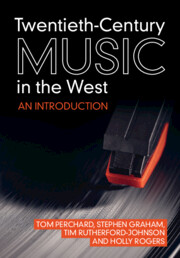Book contents
- Twentieth-Century Music in the West
- Twentieth-Century Music in the West
- Copyright page
- Contents
- Figures
- Tables
- Acknowledgements
- Introduction
- Part I Histories
- Part II Techniques and Technologies
- Part III Mediation
- Part IV Identities
- 13 Gender and Sexuality
- 14 Race and Ethnicity
- 15 Audiences, Class and Consumption
- 16 Centres and Peripheries
- Bibliography
- Index
13 - Gender and Sexuality
from Part IV - Identities
Published online by Cambridge University Press: 15 September 2022
- Twentieth-Century Music in the West
- Twentieth-Century Music in the West
- Copyright page
- Contents
- Figures
- Tables
- Acknowledgements
- Introduction
- Part I Histories
- Part II Techniques and Technologies
- Part III Mediation
- Part IV Identities
- 13 Gender and Sexuality
- 14 Race and Ethnicity
- 15 Audiences, Class and Consumption
- 16 Centres and Peripheries
- Bibliography
- Index
Summary
The twentieth century saw a huge shift in social attitudes towards gender and sexuality. The story of this shift can be told through a series of major landmarks – the suffragettes and universal suffrage, the postwar sexual revolution, Stonewall and gay liberation, second- and third-wave feminism – though social change was always both compromised and fitful, unevenly distributed and caught up in political compromise. Music both reflected and reinforced this complex pattern of social change. It served throughout the century as a powerful ‘technology of the self’ (Foucault 1988; DeNora 2000), allowing individuals to express personal and collective identities through music making or listening. These identities very often pivoted around gender and sexuality, such that musicians and audiences engaged with music that expressed their gendered and sexual identities and experiences. This took very different forms depending on the time, place and musical tradition in play; now out in the open and bold, now heavily coded or repressed. We will see this as we move through the chapter, which takes a broadly chronological look at intersections of music with gender and sexuality in the twentieth century.
- Type
- Chapter
- Information
- Twentieth-Century Music in the WestAn Introduction, pp. 321 - 340Publisher: Cambridge University PressPrint publication year: 2022



